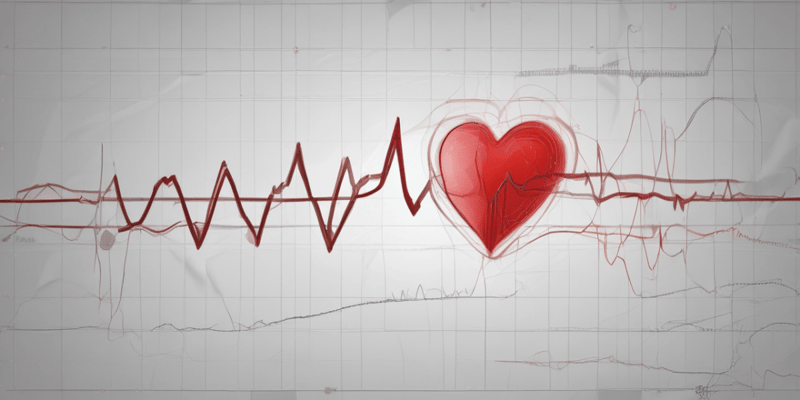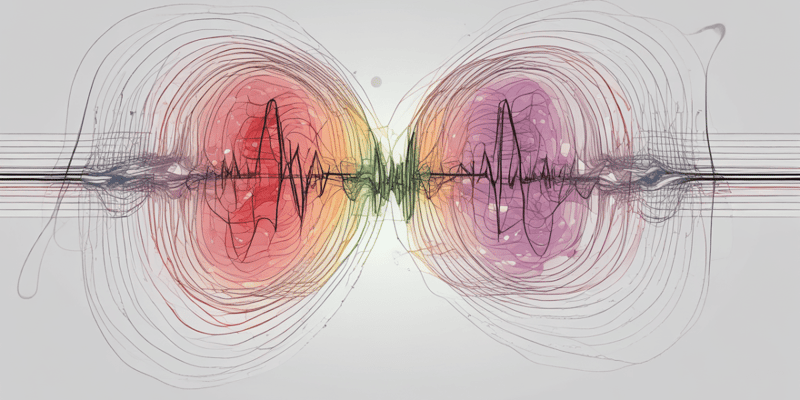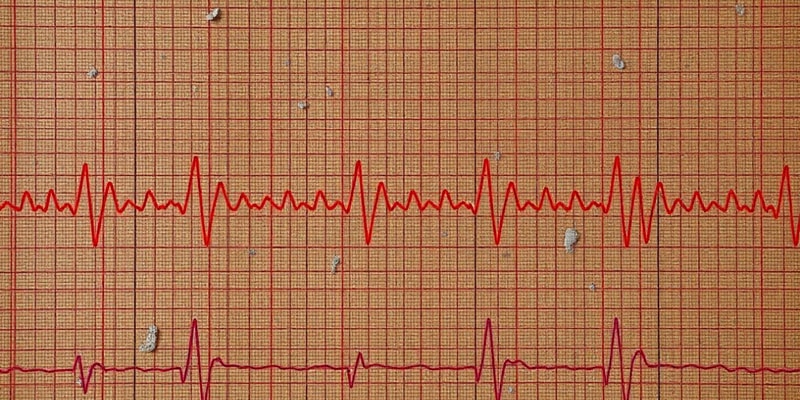Podcast
Questions and Answers
In a hexaxial lead diagram, what indicates negative poles?
In a hexaxial lead diagram, what indicates negative poles?
Which lead's positive pole is directed downward?
Which lead's positive pole is directed downward?
What does the arrow in Figure 21 represent?
What does the arrow in Figure 21 represent?
Which precordial leads have a better view of the anterior septal wall?
Which precordial leads have a better view of the anterior septal wall?
Signup and view all the answers
What is measured on the y-axis of an electrocardiogram?
What is measured on the y-axis of an electrocardiogram?
Signup and view all the answers
How much time is represented by each small box on an electrocardiogram?
How much time is represented by each small box on an electrocardiogram?
Signup and view all the answers
What is the speed of the paper on an electrocardiogram?
What is the speed of the paper on an electrocardiogram?
Signup and view all the answers
Which leads record voltages transmitted in the horizontal plane of the heart?
Which leads record voltages transmitted in the horizontal plane of the heart?
Signup and view all the answers
What is measured in leads II, III, and aVF?
What is measured in leads II, III, and aVF?
Signup and view all the answers
What is represented by an ECG as a static heart graph?
What is represented by an ECG as a static heart graph?
Signup and view all the answers
What is the duration of the small ticks on the horizontal axis in ECG?
What is the duration of the small ticks on the horizontal axis in ECG?
Signup and view all the answers
What is the vertical axis of an ECG graph?
What is the vertical axis of an ECG graph?
Signup and view all the answers
What is the calibration requirement before taking an ECG?
What is the calibration requirement before taking an ECG?
Signup and view all the answers
What is the representation of 10mm on the ECG graph?
What is the representation of 10mm on the ECG graph?
Signup and view all the answers
What is the advantage of ECG as a static heart graph?
What is the advantage of ECG as a static heart graph?
Signup and view all the answers
What is the location of the electrical activity measured in leads V1 and V2?
What is the location of the electrical activity measured in leads V1 and V2?
Signup and view all the answers
What is the rate at which the atria fire in abnormal P wave?
What is the rate at which the atria fire in abnormal P wave?
Signup and view all the answers
What is the characteristic of the baseline in abnormal P wave?
What is the characteristic of the baseline in abnormal P wave?
Signup and view all the answers
What is the origin of tachycardias with normal QRS complexes and no discernable P waves?
What is the origin of tachycardias with normal QRS complexes and no discernable P waves?
Signup and view all the answers
What is the atrial-to-ventricular conduction ratio in fibrillatory waves?
What is the atrial-to-ventricular conduction ratio in fibrillatory waves?
Signup and view all the answers
What is the reason why the ventricles cannot respond to each atrial impulse?
What is the reason why the ventricles cannot respond to each atrial impulse?
Signup and view all the answers
What is the range of the atrial rate in sawtooth/flutter waves?
What is the range of the atrial rate in sawtooth/flutter waves?
Signup and view all the answers
What is the characteristic of P waves in tachycardia?
What is the characteristic of P waves in tachycardia?
Signup and view all the answers
What is the location of the ventricles in relation to the AV node?
What is the location of the ventricles in relation to the AV node?
Signup and view all the answers
What is the direction of the wave of depolarization in a positive deflection in ECG?
What is the direction of the wave of depolarization in a positive deflection in ECG?
Signup and view all the answers
What type of deflection is seen when the mean depolarization path is directed at right angles to the lead axis?
What type of deflection is seen when the mean depolarization path is directed at right angles to the lead axis?
Signup and view all the answers
What is the purpose of using standardized and augmented limb leads in ECG?
What is the purpose of using standardized and augmented limb leads in ECG?
Signup and view all the answers
What is the location of V1 in children?
What is the location of V1 in children?
Signup and view all the answers
What is the purpose of using V3R and V4R leads in children?
What is the purpose of using V3R and V4R leads in children?
Signup and view all the answers
What type of deflection is seen when the wave of depolarization spreads towards the negative pole of the lead?
What type of deflection is seen when the wave of depolarization spreads towards the negative pole of the lead?
Signup and view all the answers
What is the purpose of using precordial/chest leads in ECG?
What is the purpose of using precordial/chest leads in ECG?
Signup and view all the answers
What is the characteristic of a biphasic deflection?
What is the characteristic of a biphasic deflection?
Signup and view all the answers
What is the reference point for the ECG machine?
What is the reference point for the ECG machine?
Signup and view all the answers
Which lead represents the voltage between the right arm and the left arm?
Which lead represents the voltage between the right arm and the left arm?
Signup and view all the answers
What is the direction of view for Lead II?
What is the direction of view for Lead II?
Signup and view all the answers
What type of leads are aVR, aVL, and aVF?
What type of leads are aVR, aVL, and aVF?
Signup and view all the answers
Which lead views the heart from the upper right side?
Which lead views the heart from the upper right side?
Signup and view all the answers
What is the direction of view for Lead III?
What is the direction of view for Lead III?
Signup and view all the answers
What is the character of the chest leads?
What is the character of the chest leads?
Signup and view all the answers
What is the reference negative value for the chest leads?
What is the reference negative value for the chest leads?
Signup and view all the answers
What is the result of depolarization towards a lead?
What is the result of depolarization towards a lead?
Signup and view all the answers
Study Notes
ECG Machine and Leads
- The ECG machine uses the negative pole as zero reference, with the positive pole as the point of view and the line connecting the two poles as the line of sight.
Limb Leads
- Leads I, II, and III are bipolar, measuring electrical potential between two of the three limb electrodes.
- Lead I: Represents voltage between the right arm (negative) and the left arm (positive), viewing the heart from the left.
- Lead II: Sees signal movements between the right arm (negative) and the left leg (positive), forming the inferior left view.
- Lead III: Measures electrical potential between the left arm (negative) and the left leg (positive), looking at the heart from an inferior right angle.
- Leads aVR, aVL, and aVF are unipolar, using one limb electrode as the positive pole and taking the average of inputs from the other two as the zero reference.
- aVR: Looks at the upper right side of the heart.
- aVL: Looks at the upper left side of the heart.
- aVF: Looks at the inferior wall of the heart.
Chest Leads
- The chest leads (precordial leads) view the heart in a horizontal plane.
- The corresponding chest electrodes serve as the positive poles.
- The reference negative value is calculated as the average of inputs from the three limb electrodes.
- Depolarization toward a lead produces a positive deflection.
Hexaxial Lead Diagram
- The Hexaxial Reference System shows the positive poles of each axis labeled with the name of the lead.
- Arrows pointed to where there is a positive electrode indicate the direction of action potentials.
Precordial Leads
- Precordial leads measure electrical activities in different areas of the heart:
- V1 & V2: Posterior wall.
- V2, V3, V4: Anterior septal wall.
- V5 & V6: Lateral wall.
Electrocardiogram Basics
- The amplitude of the waves or deflections is measured in mm on the y-axis.
- Each small box on the graph paper equals 0.04sec (40ms), while each large box equals 0.2sec (200ms).
Abnormal P Waves
- Absent P wave: Sawtooth/Flutter waves, indicating atrial firing at 250-350 bpm.
- P waves buried in the T wave of the preceding beat: Can arise from atria, rapid depolarization overriding the SA node.
- Fibrillatory waves: Atrial-to ventricular conduction ratio of 2:1, 3:1, or 4:1.
Basic Laws of ECG
- Positive (upward) deflection: Wave of depolarization spreads towards the positive pole of the lead.
- Negative (downward) deflection: Wave of depolarization spreads towards the negative pole of the lead.
- Biphasic deflection: Equal size of positive and negative deflections, seen when the mean depolarization path is directed at right angles to any lead axis.
ECG Measurements
- ECG as a static heart graph: Represents heart activity written and printed on paper as a tracing.
- ECG as a dynamic heart graph: Real-time graph of the heartbeat, usually seen in ICUs in cardiac monitors.
- Calibration of the ECG machine is necessary before taking readings.
Studying That Suits You
Use AI to generate personalized quizzes and flashcards to suit your learning preferences.
Description
Understand the Hexaxial Lead Diagram and Reference System in Electrocardiography, including negative and positive poles, and their relevance in identifying action potentials.




